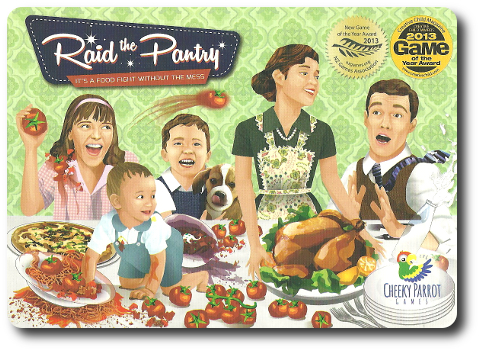
The Basics:
- For ages 8 and up
- For 2 to 4 players
- Approximately 30 minutes to complete
Geek Skills:
- Counting & Math
- Logical & Critical Decision Making
- Reading
- Cooperative & Team Play
- Hand/Resource Management
- Auctioning, Bidding, & Trading
Learning Curve:
- Child – Easy
- Adult – Easy
Theme & Narrative:
- Too many cooks in the kitchen…
Endorsements:
- Gamer Geek mixed!
- Parent Geek approved!
- Child Geek mixed!
Overview
Austrian-born American celebrity chef, restaurateur, and occasional actor, Wolfgang Puck, said “Cooking is like painting or writing a song. Just as there are only so many notes or colors, there are only so many flavors – it’s how you combine them that sets you apart.” In this game, there are only so many ingredients to go around and dishes to make. Cook fast and cook smart to taste victory.
Raid the Pantry, designed by Amanda Milne, Julia Schiller, and published by Cheeky Parrot Games, is comprised of 64 Ingredient cards, 20 Dish cards, 32 Action cards, and 4 Ingredient Distribution (Player Aid) cards. All the cards are as thick and as durable as your standard playing card. There is very little in the way of illustrations provided in the game, with the vast majority of the cards depicting photographic images of food. Think cook book and you’ve got the right idea. Also, do not play this game on an empty stomach.
Seriously.
Prepping to Cook
To set up the game, fist separate the cards into 4 different piles. Use the back of the cards to help quickly divide the cards by type. When done, there will be an Ingredient, Action, Dish, and Ingredient Distribution card piles.
Second, shuffle the Dish card pile and deal 3 Dish cards to each player, face-down. Place the remaining Dish cards face-down in the middle of the playing area. This is the Dish draw deck for the duration of the game.
Third, shuffle the Ingredient cards and deal 3 Ingredient cards face-up and in a column so the titles of each Ingredient card are visible and overlapping. This column of cards is referred to as the “Rubbish Bin”.
Fourth, deal 6 Ingredient cards to each player, face-down. These cards are added to the player’s Dish cards to form the player’s starting hand of 9 cards (players should look at their cards now, but keep them hidden until played). Place the remaining Ingredient cards face-down in the middle of the playing area. This is the Pantry draw deck for the duration of the game.
Fifth, shuffle the Action cards and place the deck face-down in the middle of the playing area. This is the Action draw deck for the duration of the game.
That’s it for game set up. Determine who should go first and begin.
If You Can’t Stand the Heat…
Raid the Pantry is played in turns with no set number of turns per game. A player’s turn is summarized here.
Step 1: Draw One Action Card
A player always starts their turn by drawing 1 Action card from the Action draw deck.
If the drawn Action card has the “Whisk” symbol, the player must use the Action card immediately, resolving it before continuing their turn. After the Action card is used, it’s discarded. If the Action card drawn has the “Whisk” symbol and cannot be used by the player (due to the Action card’s requirements), then it’s discarded and a new Action card is drawn.
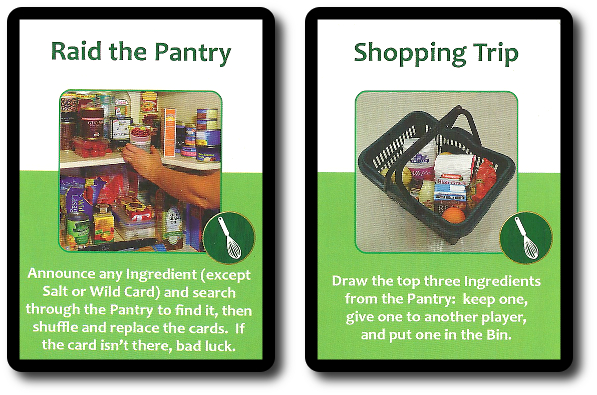
If the drawn Action card has the “Container” symbol, the player can choose to use the Action card immediately or save it for later, placing it in their hand.
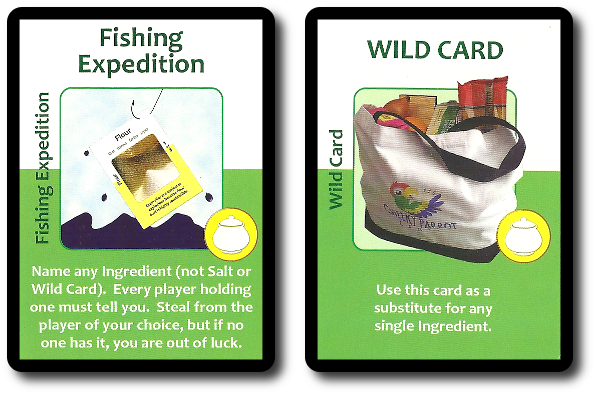
If the drawn Action card has arrows around the “Container” or “Whisk” symbol, the card is played per the symbol’s rules (immediately or later) as already defined. In addition, the arrows allow each opponent, in turn order sequence, to also take an action after the player resolves the Action card.
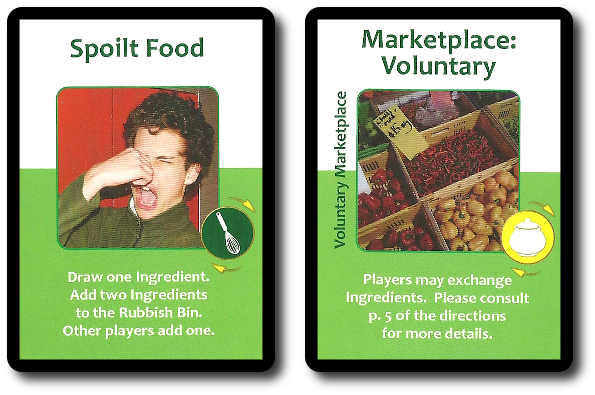
Action cards are always discarded face-up. Regardless of the outcome of the Action card draw, the player is always welcome to use Action cards with the “Canister” symbol during this step or at anytime during their turn. If the Action draw deck is ever exhausted, shuffle the discard pile to create a new draw deck.
Step 2: Get Cooking
If the player has the correct number and type of Ingredient cards that are required by a Dish card, they can play the Ingredient cards listed and the Dish card they create. Wild cards can be used at this time to substitute for missing Ingredient cards, except those noted on the “Instant Bonus Dish” Action card. Played Dish and Ingredient cards remain face-up in front of the player. This area is referred to as the player’s “Cupboard”. A new Dish card is always drawn to replace any Dish cards played to the player’s Cupboard.
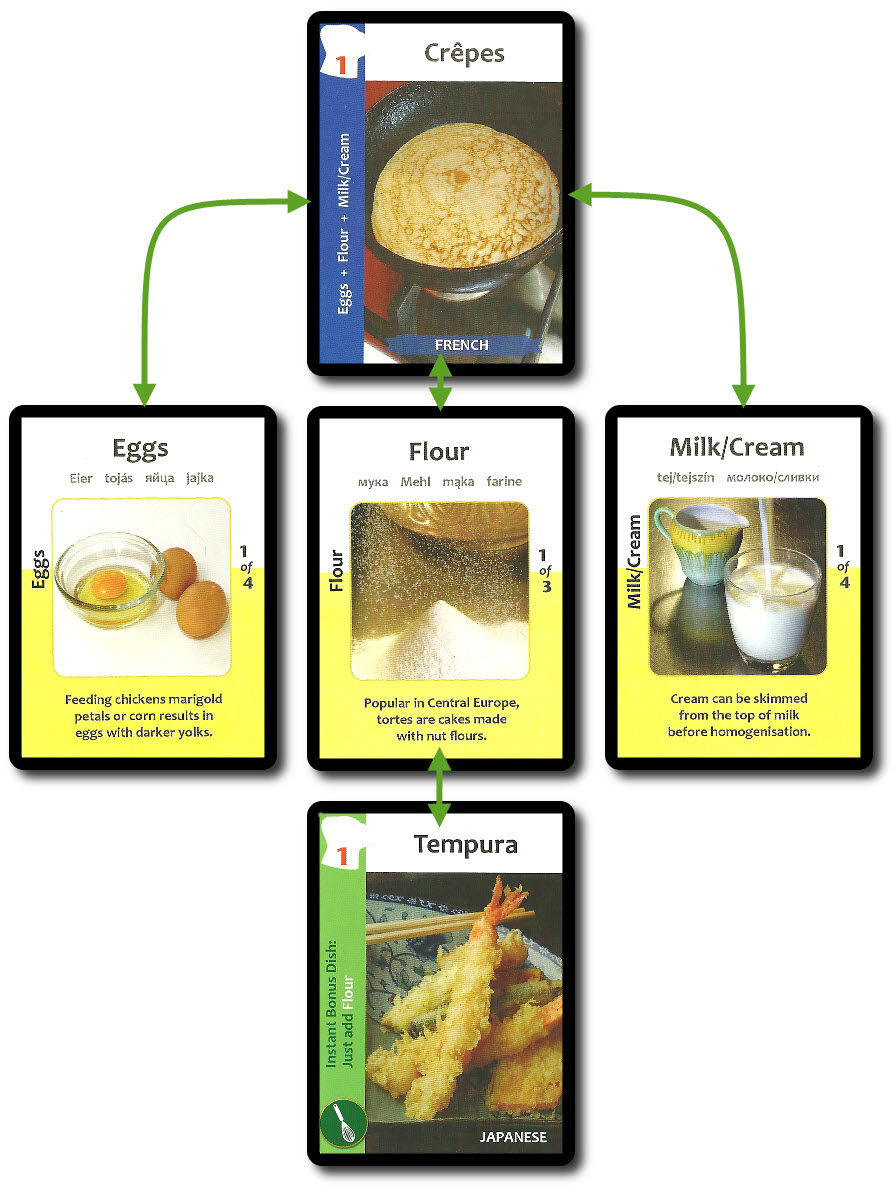
This player has earned 2 points, with the “Flour” Ingredient card being used for 1 Dish card and 1 “Instant Bonus Dish” Action card
Playing as quickly as possible to the Cupboard is a good way to not only lock in points, but to also protect a player’s assets. Any card in the player’s Cupboard is protected. These cards cannot be lost or be given away. However, the Ingredient cards can be reused to complete the requirements of future Dish cards.
On the off-chance that a player is holding or later receives an Ingredient card that was substituted with the Wild card, the player can replace the Ingredient card with the Wild card, taking the Wild card into their hand. The Wild card can be held for later or used immediately for cooking. A player can also take a Wild card from an opponent’s Cupboard, but only if they give that opponent the Ingredient card they are substituting the Wild card for. In this way, the Wild card is the only non-Ingredient card that can be moved around in any player’s Cupboard, but is never really taken, since it’s always replaced with a valid Ingredient card.
As the game progresses, players will be forced or can volunteer to participate in the “Marketplace” Action card. This triggers an exchange of Ingredient cards with all the players in the game. This is another way Ingredient cards can be cycled and might end up in the right or wrong hands.
Step 3: Take a Breather
After playing Action cards and completing as many Dish cards as possible (or strategically believe to be necessary), the player can announce that they have completed their turn. The next player in turn order sequence now goes starting with step 1 noted above.
Stay Out of the Kitchen
The game continues, with players taking turns, until 1 player has earned enough total points to win the game. The number of points necessary to win is determined by the number of players. For example, the first person to score 16 points in a 2-player game wins and the first to score 10 points in a 4-player game wins.
Points are earned by playing Dish cards. Not all Dish cards provide the same number of points. The more complicated the meal, the more points the player will earn. A player can also earn the “Cuisine Bonus”, which is given when the player is able to play 2 or more Dish cards from the same cuisine (French, Japanese, etc.). The number of bonus points earned is based on the total number of Dish cards played from the same cuisine. The “Salt” and “Instant Bonus Dishes” also add 1 point each when counting up a player’s points.
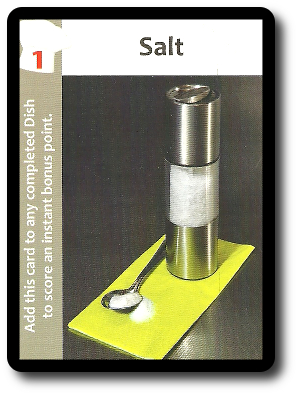
Game Variant
If playing with 4 players, Raid the Pantry can be played with teams with 2 players per team. Partners play across from each other and share a Cupboard, as well as points. Table talk is allowed. Set up and scoring is slightly different than the normal version of the game, but the primary game play remains intact. The most interesting change is the “Instant Bonus Dish” Action card. If a player draws it and does not have the necessary Ingredient card in their hand or in their Cupboard to fulfill it, they may ask their partner if they have it. If not, the “Instant Bonus Dish” Action card is placed face-up next to the Action card draw pile (not in the discard card) and can be claimed by any player on their turn who has the necessary Ingredient card.
To learn more about Raid the Pantry, visit the game’s website.
Final Word
The Child Geeks weren’t so sure about a game that dealt with cooking, as the idea of doing something in the kitchen didn’t exactly communicate “excitement” or “adventure”. After teaching the game, which was blissfully easy, the Child Geeks felt more confident about the game’s ability to entertain them. As the games began to be played, we observed an interesting phenomenon. The Child Geeks who were able to quickly complete Dish cards were having a blast. The Child Geeks who were having trouble were sulking. Which is, in and of itself, not that surprising. What was surprising is that the Child Geeks felt completely different – as in a complete polar opposite – about the game depending on how well they were doing. Their attitude towards the game shifted each time they played, positively or negatively slanted based on their ability to compete. According to one Child Geek (who wasn’t winning), “This game is just impossible. I can’t get the cards I need and I can’t score points.” The same Child Geek who later was able to get the cards he needed said, “This game is awesome! I feel like I’m really cooking some great stuff!” The same behavior and attitude was observed in every Child Geek who played. The end result was a mixed approval from the Child Geeks, based heavily on how well they did in the game.
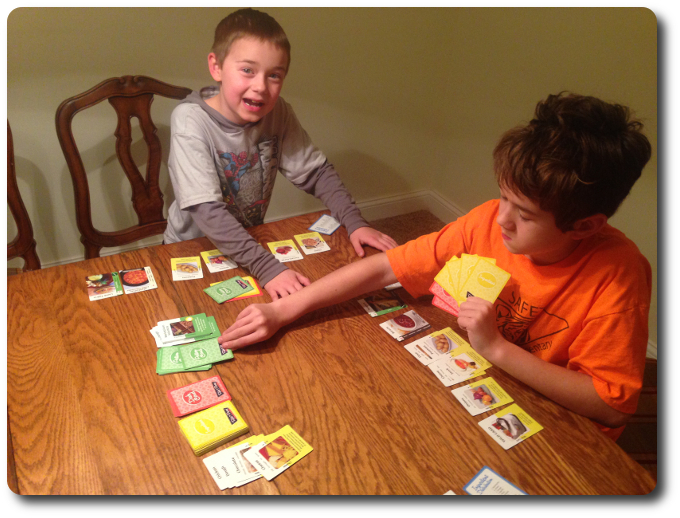
As the games progressed, some Child Geeks became ecstatic while others trudged along
The Parent Geeks also had difficulty at times getting the cards they needed, but they saw this as a challenge, not a detriment. As one Parent Geek put it, “The game can either go in your favor or not, but in either case, you still have to work for your points. It’s just that sometimes it’s easier and sometimes it’s harder, but it’s always fun.” Another Parent Geek said, “I’m really enjoying this. I like that we can reuse cards and the way players softly interact with each other, providing just enough player to player competition to make it fun, but not overly aggressive.” The game also sparked more than a few conversations about past cooking experiences and kitchen experiments. A number of the Parent Geeks were also inspired to create some of the dishes portrayed on the Dish cards. When all the games were over, the Parent Geeks fully approved Raid the Pantry.
The Gamer Geeks were not fond of how the game looked or how dependent players were on luck. As one Gamer Geek put it, “I think the game is designed well enough, but it still has a few bolts to tighten. Too random at times and some players seem to get all the cards they need while others are left out in the cold.” Another Gamer Geek said, “The theme is fine, but without giving players more control of their card choices and chances to get what they need to score points, it feels like a game about starving the player instead of feeding them a game worth biting into.” What it really came down to was what the Child Geeks already observed: sometimes the game just doesn’t give the player the right cards. This irritated the Gamer Geeks, as it essentially made them powerless. The end result was the Gamer Geeks rejecting Raid the Pantry.
The game has a few sore spots. To begin with, a player’s primary method of receiving cards is through random draws. This makes it difficult to collect cards towards specific Dish cards. The lack of hand size restrictions and the Rubbish Bin helps, but not entirely. At most, it reduces stress, but not the frustration of being unable to claim specific Ingredient cards. Second, this game favors those who are able to complete Dish cards early. While I would not go so far as to say that Raid the Pantry has a runaway player problem, any player who is able to complete Dish cards and start building their Cupboard has a clear advantage over those whose Cupboards are bare. Finally, players can get stuck with Dish cards they cannot hope to score unless they get the “Wild” Ingredient card and sometimes not at all due to the necessary Ingredient cards already being secured in an opponent’s Cupboard. As the game progresses, it will become increasing difficult to complete Dish cards worth a great deal of points, making it a challenge to close point gaps.
And while this might sound like I am painting a negative picture, that is not the case. The sore points I mention serve to make the game more difficult, not impossible. Players who gravitate towards games that make the road to victory obvious will quickly find Raid the Pantry to be a game that is difficult to navigate. But nor is this an overly difficult game. It is, in fact, nothing more than a game that forces a player to think and to accept the very real possibility that they might be stuck for a few turns. This is a game that depends less on momentum and more on opportunity. Opportunities that might come in abundance or in fleeting moments. All the while, any player can take comfort in knowing that their opponents are tackling the same issues, meaning no one player is ever singled out or dealt an unfair hand.
Theme wise, Raid the Pantry plays well to the foodies and chefs, offering a wide variety of exotic dishes and interesting ingredients. But the game also did well with those who couldn’t give two hoots about any of that nonsense and just wanted to play a game. There is something very satisfying about putting down Ingredient cards and announcing the Dish card is helped create. There is a sense of completion, of bringing things together that make sense. All our players felt this and their sense of success only grew as their Cupboard became filled with the spoils of their cooking frenzy.
Overall, I am pleased with the game. As Rummy-style games go, Raid the Pantry is a good one, offering its players a challenging and entertaining opportunity to combine and collect cards based on an ever shrinking resource. The game has more “luck of the draw” in it than I would like, as I have a hard time appreciating my lot in life when the challenge I am now facing is based purely on randomized outcomes. Still, a player is never sentence to the corner or denied an opportunity to get back in the game. There will most certainly be winners and losers and it’s often easy to lament your defeat on poor cards. But so what? Each game plays quickly, engages the players, and keeps everyone on their toes. If you enjoy cards games that are easy to learn, but not in the least bit easy to win, then do play Raid the Pantry. I think you’ll find the heat in this kitchen to be tolerable, but not altogether comfortable at times.
This game was given to Father Geek as a review copy. Father Geek was not paid, bribed, wined, dined, or threatened in vain hopes of influencing this review. Such is the statuesque and legendary integrity of Father Geek.



